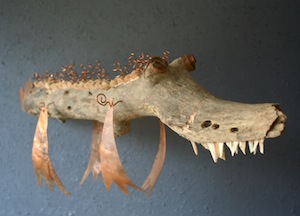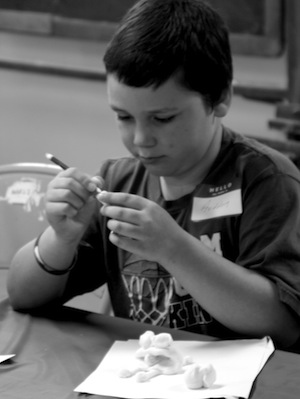Got Woodwork??
By Hope Wallace

Pieces have begun to creep in for our “Out of the Wodwork” exhibit scheduled to open on July 4. Do you have something unique that has been hand-made out of wood? If so, there is still time to enter it in this outrageous exhibit! Now, here is the easy part. You do not have to have personally made it! You can enter something created by a grandparent or purchased from a garage sale. The item simply cannot be made from a kit. From wooden mobiles, to alligators made out of logs, abstract carvings to traditional furniture, this show truly is off the wall and Out of the Woodwork!
Call us at 419.238.6837 for entry information. This exhibit promises a way to get ideas and learn much about the intrinsic creative nature of human beings.
The Wassenberg Art Center’s art camp, taught by Pat Rayman began today with eight young people attending. Pat is an established area artist and painter whose work has been published commercially and broadly represented. She is an art and art history instructor at Wright State University and we are fortunate to have her skills here at the Wassenberg Art

Center.
The next upcoming class is Line Art Initial! July 16 from 10 a.m.-noon. This class is taught by Scott Kraemer of Bryan, one of our exhibiting artists. This is great fun, a valuable use of self-expression and is the up and coming cool-trend. A limited number of scholarships are available for this class, so sign up early!
July 19, Wild Women! Wild Women pins are hand-crafted and made from multi-media and found objects. This class is going to be held on July 19 from 6-9 p.m. A crazy array of different personalities will emerge from this class! In August we have Batik for adults and kids. Stayed tuned for further details!
The Wassenberg Art Center is located at 643 S. Washington Street in Van Wert, Ohio. Contact the center at 419.238.6837 or wassenberg@embarqmail.com.
Toning it up – or down
By Kay Sluterbeck

If you have access to a copy machine, it’s interesting to put a brightly colored picture into the machine and run a copy of it in black and white – and then compare the two images. The black and white picture will make you considerably more aware of the fine distinctions of tone (the relative lightness and darkness of any picture). Subjects in black and white seem clearer and more resolved – and therefore easier to paint or draw – than they do in color.
Artists who want to work in a realistic style need to be aware of differentiations in tone and value (value refers to the lightness or darkness of a specific area). Accurate representation of tonal values is vital for the success of any painting that sets out to recreate three-dimensional reality. It’s much harder to represent tonal values in color, and this is where the grisaille technique comes in.
Grisaille (gree –ZAY) is the French word for gray. The technique was developed during the Renaissance and is still in wide use today. The artist paints an underpainting in shades of gray, black, and white; then transparent or semitransparent colors are glazed on until the desired effect is achieved. (A glaze is a transparent mixture of paint and a thinning medium; when brushed on it allows the underlying layer to show through.) In modern times, the word grisaille can also refer to a monochrome painting rendered in grays.
Duplicating tones by making a painting in shades of grey can be challenging. We can see that objects appear to be light and dark. For instance, a person may have dark hair and pale skin. However, the tones we want to represent in paintings are the effect of light striking objects. If the light of a lamp falls upon that person, even though his skin is pale, one side of his face will be light and the other side will be in darkness. If the lamplight is very bright, the tonal differences will be accentuated to form light, bright shapes and dark shadows.
The type of light also makes a difference in how tones appear. Sunlight can give harsh clarity to a scene. A colorful beach ball in intense sunlight will appear bleached out by the light. On the other hand, objects bathed in soft, uniform light will show a whole range of half-tones. Because the tonal contrasts are not so glaringly obvious, we have to look harder for them, and must try not to confuse color with tone.
To see tonal values more accurately, try half-closing your eyes while looking at a scene. Blurring your focus slightly will remove confusing details and let you see the differences between tones.
There is an old saying, “All cats look black at night.” This is because subdued lighting conditions give us the most resolved experience of tone. In these conditions we are using the rod cells in the retina rather than the cone cells, and it is the latter that distinguish color. You can experiment with tone by turning off almost all your house lights at night. Use a single lamp or candle, and put it in different places; you’ll see a wide variety of dramatic tonal effects. Art schools sometimes use black mirrors to create similar effects for experiments in tonal drawing. If you’ve looked at your reflection in a bus window at night, you’ve seen the same kind of tonal image.
But even if you understand tones and values, how do you use them in artwork? In our next column, we’ll discuss methods of making a tonal drawing and grisaille painting.
POSTED: 06/29/11 at 1:19 pm. FILED UNDER: What's Up at Wassenberg?







